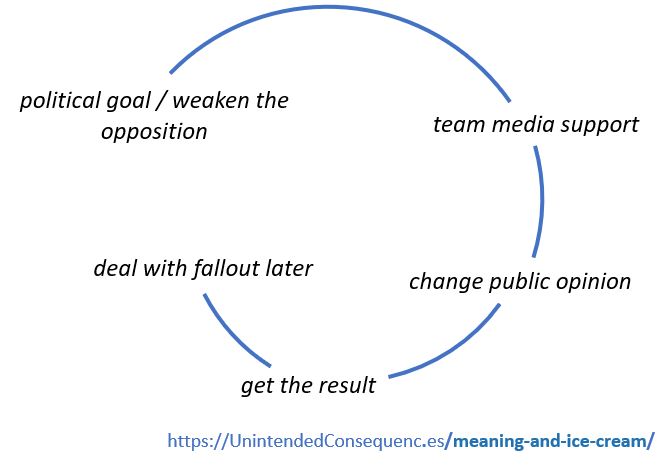Star Spangled Ice Cream (shuttered for over 10 years) started as a conservative option to liberal Ben & Jerry’s. I’m not sure why it shut down, but some of its flavors sound just bad (John Kerry Ketchup Dough) and used suspiciously similar puns to their main competition (Cherry Falwell vs Cherry Garcia).
Why there is a market for liberal, but not conservative, ice cream is the wrong question. Liberals and conservatives are mostly the same when it comes to food.
Just as there is liberal ice cream, there is conservative chicken. Chick-fil-A serves chicken sandwiches, but runs itself based on conservative Protestant values, including keeping locations closed on Sundays. Like Ben & Jerry’s, I doubt many people choose to eat or not eat Chick-fil-A because of the founder’s beliefs. Those beliefs are what they are and the products are what they are. There might be a liberal or conservative business model (sourcing, fair trade, pricing, staff treatment, etc) but the ingredients and flavors have to work.
That was the problem with Star Spangled Ice Cream. Its founding was ideology rather than flavor. In the end, ideology wasn’t enough.
What is the product?
But when ideology itself is the product, things are different.
Emerging global events take time to understand, so if the starting point is an ideological frame, then we lose perspective — on purpose. For media products, starting with an ideological frame does make business model sense today. (For why this wasn’t always as extreme, see Loop In, Loop Out – Business Models and Media and What is Unity? – Post-Election Questions.)
Let’s look back. When there is a single state media perspective (in the now quaint and overly simplified Cold War Soviet style), a continuum of control could look like this:

But for much of the world, that environment stopped working. Instead, there is more of a process — even if it is a downward spiral — which works something like this:

Levers for the spiral include:
- The Clip. Using a snippet of a comment, quote, or video to support a side when the actual meaning may be something else entirely. This technique was a factor in the Covington Catholic “smirk.”
- The Single Explanation. Believing or disbelieving based on a single explanation rather than evidence presented. This was a factor in early interpretations of the COVID lab leak hypothesis (first interpreted as racist in the US; now considered a serious explanation) and calls for due process during Kavanaugh’s hearings (considered scandalous when a law school professor, of all people, did it).
- The Single Solution. Promoting only one cure for a problem, for example, creating vaccine mandates rather than a mix of solutions. This was a factor in Italy’s Green Pass, where vaccinated people maintain valid status even if they test positive for COVID.
No one has a natural monopoly on objectivity. When one side comes to the end of a short-term battle to convince because contrary evidence is overwhelming — the election has already been won, the policy adopted — people already feel the effect. Adding a correction (if it happens) doesn’t change the past.
Promoting misinformation or disinformation seems to be an increasingly used tactic (and it might not always be intentional).
However, those who consider themselves more in the political center (lots of people here) who already didn’t trust obviously Republican or right-leaning media are now losing their trust for Democrat or left-leaning media.
But if these publications acted badly and lost trust, it wasn’t rash. It was a basic values decision that melded with a new business model.
Fox News, Breitbart, and others like them were already considered low-quality and biased, The New York Times, CNN, and MSNBC have simply adopted the same playbook as their ideological competitors.
If right-leaning media wanted to capitalize on this time to capture more of the mainstream, they may be able to do it. It seems like a once-in-a-generation opportunity, but difficult for any large media organization to achieve.
Ben & Jerry’s built an ice cream business and only afterward used their following to preach their politics, but that change increasingly gets them into difficulties. By needing to comment on more and more issues (as they were forced to comment months ago on Israel’s bombing of Gaza), political distractions will guide more of their business, as now during the Rittenhouse Trial.
I doubt that Ben & Jerry’s will win many new customers solely from professed political judgment. They may lose a small number of customers, but that may be worth it for their basic values. Either way, their product is not ideology, but ice cream.
The good thing about a reevaluation of media bias is that we have the potential to move away from the business models that helped create the problem in the first place. I hope we will see it. Flavors can change.